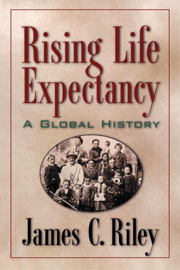Book contents
- Frontmatter
- Dedication
- Contents
- List of Figures, Maps, and Tables
- Preface and Acknowledgments
- Introduction: A Global Revolution in Life Expectancy
- 1 A Brief Overview of the Health Transition
- 2 Public Health
- 3 Medicine
- 4 Wealth, Income, and Economic Development
- 5 Famine, Malnutrition, and Diet
- 6 Households and Individuals
- 7 Literacy and Education
- Conclusion
- Index
Preface and Acknowledgments
Published online by Cambridge University Press: 05 February 2015
- Frontmatter
- Dedication
- Contents
- List of Figures, Maps, and Tables
- Preface and Acknowledgments
- Introduction: A Global Revolution in Life Expectancy
- 1 A Brief Overview of the Health Transition
- 2 Public Health
- 3 Medicine
- 4 Wealth, Income, and Economic Development
- 5 Famine, Malnutrition, and Diet
- 6 Households and Individuals
- 7 Literacy and Education
- Conclusion
- Index
Summary
People have long imagined that they might individually live to old age. For most of human history, threats to survival overwhelmed this idea. A few people lived to be old, but most of the members of any society died young. Until the early twentieth century more people died in infancy than at any other age. Reaching old age became a commonplace thing only in the twentieth century. This is a history of the retreat of death and the democratization of survival to old age in the period since about 1800.
Survival and health should be distinguished. A person may be alive but not well. The difference matters because disease and injury have not retreated as far as death has. Morbidity, in the sense of sickness prevalence, remains high in all societies, in some because communicable diseases are so common and in some because protracted noncommunicable diseases have taken their place. Moreover, the factors that influence sickness and death seem to overlap only in part, and often to influence these two effects differently. In a future stage of the global health transition, sickness prevalence, too, may be forced back.
Two main arguments are developed in this book. The first main argument is that individual countries, sometimes even regions within countries, devise their own strategies for reducing mortality. People have always selected from the same six tactical areas: public health, medicine, wealth and income, nutrition, behavior, and education.
- Type
- Chapter
- Information
- Rising Life ExpectancyA Global History, pp. x - xiiPublisher: Cambridge University PressPrint publication year: 2001



